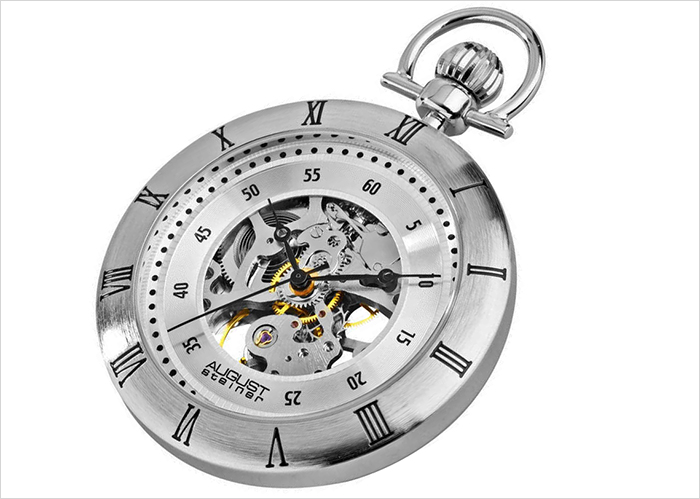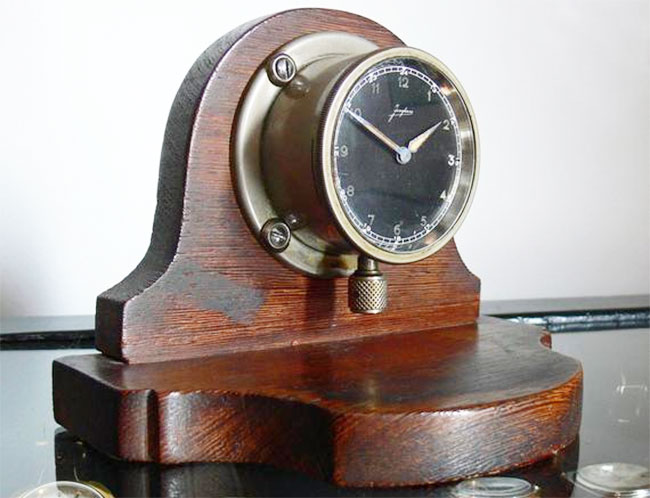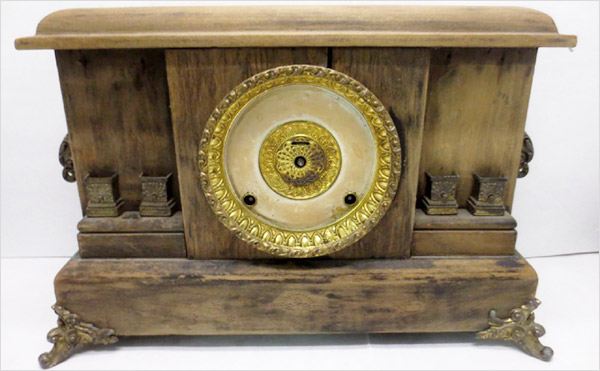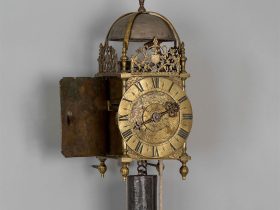Clock collectors or antique enthusiasts can easily find old and vintage American clocks for sale in flea markets, antique shows, in NAWCC (National Association of Watch and Clock Collectors) meetings, on eBay, and other various places throughout the United States.
Thanks to the Golden Age of American Clockmaking (circa 1800 – 1900), we can find today with less difficulty many great pieces of antique American clocks that come in different ages, styles, qualities, movements, and materials used.
A brief history of American clockmaking
American clocks are first mentioned as early as 1650 in various town records. But these clocks were commonly large tower or public building clocks that were actually made by European clockmakers.
Who was the first American who invented the clock?
A controversy would arise when we talk about who was the first American to build a clock. There were claims that in late 1600s horologists like William Davis and other immigrants coming from Europe were the real pioneers who said to be the first to make clocks in America.
But there is no solid evidence to substantiate the claim. Some clock historians would suggest that they might have only pretended to be clockmakers when in fact they only repaired clocks.
Early American clocks (1700 – 1800)
By 1700s, there were many clocks in America that it naturally attracted both young and old clockmakers and horologists from the Old World to settle in the country. Most of them set up their shops in the wealthier locations in Boston and Philadelphia, and then later on in Connecticut, Maryland, New York, and Rhode Island.
The most prominent clockmakers during those years were Samuel Bispham, David Rittenhouse, Chauncey Jerome, Abel Cottey, Thomas Harland, Daniel Burlap, Simon Willard, Seth Thomas, and several others.
However, from 1700s up to 1800s, the clocks were patterned only after the European models and were commonly tall clocks, which were later on called grandfather clocks.
The American Revolution that began in 1763 eventually turned clockmakers into making guns and bullets. When the war ended, clockmaking resumed with predicament for lack of supplies in metals. Out of necessity, clockmakers started to design smaller clocks that were also less costly.
One of the first clock-makers in America, Thomas Harland (1773 – 1807), began to produce his own standardized designs and interchangeable parts of his tall case clocks. He was able to train Daniel Burlap (1759 – 1838) of his specialized methods. Harland’s legacy extended to Eli Terry when Burlap trained him also.
American Clockmaking Golden Age (1800 – 1890s)
Around 1800s, clockmakers in America were able to find a way to make tall clocks with wooden movements rather than brass, making them more affordable to the consumers. The years that followed proved to be the golden era of American Clock Industry.
The years were characterized by the clocks’ remarkable styles, high quality designs, and innovative features created by great American clock-makers such as Simon Willard, Seth Thomas, Eli Terry, Chauncey Jerome, and Elnathan Taber.
In 1830, Eli Terry started to produce mantel clocks in great quantity and marketed them to the global market.
The great era of American Clockmaking continued to thrive on in the 1800s to 1890s, and even in the early 1900s, enriching the world with simply amazing antique American clocks that are still running even until today.
Major types of antique American clocks
There are four major types of the original vintage American clocks such as the following below:
Antique American tower clocks
The very first antique American clocks are the Tower Clocks, or also known as Turret Clocks. At the outset of American Clock History, only those who could afford to own a clock were the wealthy colonists. Indeed, clocks during that time were, and still are today to some extent, a symbol of status in the community.
Since not everyone owned a clock, each wealthy town needed a large tower clock mounted in a most prominent location in the area for everyone to see. The earliest tower clocks were without hands and face but only a certain mechanism that would cause a bell to sound at fixed intervals.
Later on, a dial, hands, a pendulum, and improved escapements were added. The best known tower clockmakers were Simon Willard, Eli Terry, Seth Thomas, and Edward Howard.
Antique American grandfather clocks
Grandfather clocks, or originally known as tall clocks, are the second type of vintage American clocks. They are also called Long Case, Floor, or Hall Clocks. But the most popular name is the Grandfather clock.
The height of American antique tall case clock ranged from five to nine feet with wood cases and charming designs that varied according to the desired style of the designer.
The wooden case for the movement conceals the pendulum and weights as well as a good way to keep out the dust. American tall clocks became very popular in 1670s till the 1700s especially in Connecticut, Massachusetts, and Pennsylvania, which were the centers of tall clock manufacturing during those years.
In the first models of American long case clocks, the dials were made of metal with unornamented cases, and no arch. Later on, the calendar, phases of the moon, a rocking ship design on the pendulum, and musical devices had been added.
Furthermore, there were four types of movement used such as the 30-hour brass movement, the 8-day brass movement with two weights, the 30-hour Connecticut wood movement, and the 8-day wood movement.
Antique American wall clocks
American old wall clock designs were similar to tall clocks. As the name suggests, this third type of antique American clock is hung on the wall. They came in various shapes and styles. One good example of its earliest model is the Wag-on-Wall Clocks.
Most sought after antique American wall clocks, a 30-hour brass movement, are those designed by Simon Willard in 1783. They are widely considered a great American masterpiece.
Most notable vintage American wall clocks were made by Connecticut clock-makers – the famous beautiful styles of wall clocks such as the Lyre Wall Clock, Wag-on-Wall, Wall Regulator, and the Wall Wagon Spring. A few of them still survive today.
Simon Willard also created one of the finest wall clocks that he called the Banjo Clock.
Antique American mantel clocks
Mantel clocks, or also known as shelf clocks, are another most important type of antique American clocks. Introduced between 1750 and 1760, American shelf clocks were a result out of necessity especially with the cost of tall clocks and the scarcity of metal supplies.
American mantel clocks were considerably small with an average height of 24 to 30 inches, and could run from 30 hours up to 8 days.
The clocks became an instant hit in the market mainly because of their affordability. The pioneers of US mantle clocks include Simon Willard, Daniel Balch, David Wood, Seril Dodge, Levi Hutchins, among others.
Then in 1815, Eli Terry mass produced affordable US mantel clocks and eventually credited to be the clockmaker who had considerably change the landscape of American Clockmaking.
Antique American cuckoo clocks
Vintage cuckoo clocks can be considered a minor type when it comes to antique American clocks.
But they have been one of the most beloved novelty clocks in the US.
In the late 1800s till early 1900s, American cuckoo clocks became in vogue especially those models made by the Lux Company and the American Cuckoo Clock Company of Philadelphia.
Famous antique American clock makers and manufacturers
Since the beginning of the History of American Clockmaking, manufacturers of different types of clocks were mainly highly skilled individuals. The year 1840 marked the year when Chauncey Jerome founded the largest clock factory and marketed the clocks all over the world.
Since then, other major clock companies in America have emerged that in 1852 the country recorded a total of more than 30 clock manufacturers all over the US. Millions of clocks were made between 1840 and 1890 alone and many of them have survived even until today, which are highly priced by collectors.
That said, here is an overview below of some of the most prominent antique American clock makers and manufacturers:
Simon Willard antique clocks
Simon Willard (April 3, 1753 – August 30, 1848) is one of the most famous vintage American clock makers. His Banjo Clocks and Shelf Clock are highly valued and most sought after by collectors today.
Eli Terry antique clocks
Eli Terry (April 13, 1772 – February 24, 1852) is known as “the last craftsmen and the first industrialist” in the History of American Clockmaking. He had greatly influenced the US clock making industry when he produced massive quantity of affordable clocks in 1800s. In 1807 alone, Terry started to make 4,000 wood clock movements and finished them in 1810.
Ansonia antique clocks
The Ansonia Clock Company was founded in 1851. This American clock manufacturer specialized in stylish clocks, specifically for collectors. Several of Ansonia’s collections include the figurine (statue) clocks, mantel clocks, swinging clocks, and various novelty clocks. Ansonia recorded a total of 225 collectible clocks in 1886.
Seth Thomas antique clocks
Seth Thomas Company is one of most celebrated 19th century American clock manufacturers and another pioneer of mass production of clocks. Seth Thomas (1785 – 1859) once partnered with Eli Terry and produced together over 10,000 low-priced clocks every year in early 1800s.
William Gilbert antique clocks
William Gilbert (1806 – 1890), this famous American clockmaker started producing clocks in 1828 in Connecticut. His short-lived Gilbert Manufacturing Company (1866-1871) had produced good quality clocks during its operation. It was able to re-emerge later with a new name William L. Gilbert Clock Company.
William L. Gilbert antique US clocks are highly valued collectibles today for their heirloom quality.
Elias Ingraham antique clocks
Elias Ingraham (1805-1885) was another highly noted American clockmaker for his beautiful clock designs. His Elias Ingraham steeple clocks became in vogue in 19th century that many designers wanted to copy the style but failed.
Other highly valued collectibles of Ingraham vintage clocks are the so-called Figure 8 Designs, which are simply graceful in appearance as well as very appealing to the eyes.










Leave a Reply